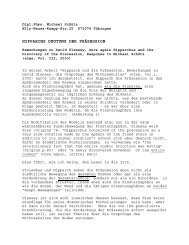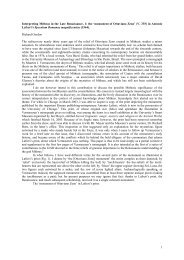A new Mithraic relief in the Israel Museum, Jerusalem
A new Mithraic relief in the Israel Museum, Jerusalem
A new Mithraic relief in the Israel Museum, Jerusalem
You also want an ePaper? Increase the reach of your titles
YUMPU automatically turns print PDFs into web optimized ePapers that Google loves.
A <strong>new</strong> <strong>Mithraic</strong> <strong>relief</strong> <strong>in</strong> <strong>the</strong> <strong>Israel</strong> <strong>Museum</strong>, <strong>Jerusalem</strong><br />
A summary of A. de Jong, ‘A <strong>new</strong> Syrian <strong>Mithraic</strong> Tauroctony,’ Bullet<strong>in</strong> of <strong>the</strong> Asia Institute<br />
n.s. 11 (1997) [2000], 53-63. A shorter popular version, with some differences of<br />
<strong>in</strong>terpretation, may be found <strong>in</strong> id., ‘A <strong>new</strong> <strong>Mithraic</strong> <strong>relief</strong>,’ The <strong>Israel</strong> <strong>Museum</strong> Journal 16<br />
(1998), 85-90. Both are illustrated.<br />
An <strong>in</strong>terest<strong>in</strong>g <strong>new</strong> <strong>Mithraic</strong> <strong>relief</strong>, with several unique features, formerly <strong>the</strong> property<br />
of Mr. Samuel Merr<strong>in</strong>, was presented to <strong>the</strong> <strong>Israel</strong> <strong>Museum</strong> <strong>in</strong> <strong>Jerusalem</strong> <strong>in</strong> 1997 by its<br />
American Friends (<strong>in</strong>v. no. 97.95.19). It is a limestone slab, measur<strong>in</strong>g 65.7 x 49 x 9.5 cm,<br />
divided <strong>in</strong>to a central ‘cave’, conta<strong>in</strong><strong>in</strong>g <strong>the</strong> ma<strong>in</strong> scene and four o<strong>the</strong>rs, with panels on ei<strong>the</strong>r<br />
side (see Fig. 1).<br />
The central scene shows a conventional Mithras, <strong>in</strong> Parthian-style clo<strong>the</strong>s, and wear<strong>in</strong>g<br />
boots, kill<strong>in</strong>g <strong>the</strong> bull. On his belt hang two sheaths conta<strong>in</strong><strong>in</strong>g daggers or swords, and he<br />
holds a third <strong>in</strong> his right hand. A small dog jumps up at <strong>the</strong> front on a convenient shelf, well<br />
away from <strong>the</strong> wound, while a small snake skulks <strong>in</strong> <strong>the</strong> lower right corner; a rudimentary<br />
raven, look<strong>in</strong>g ra<strong>the</strong>r like a plucked chicken, peers down at Mithras’ Phrygian cap. The bull’s<br />
tail hangs down, just as on several <strong>Mithraic</strong> <strong>relief</strong>s from Syria; <strong>the</strong>re is an obscure limp above<br />
it which may represent <strong>the</strong> scorpion, of which <strong>the</strong>re is o<strong>the</strong>rwise no sign [or possibly a lion,<br />
fac<strong>in</strong>g right?]. Above <strong>the</strong> cave entrance are posed <strong>the</strong> busts of radiate Helios (l.) and Selene,<br />
backed by a crescent, separated by a row of 7 stars. The places usually taken by <strong>the</strong> lum<strong>in</strong>aries<br />
are here occupied by <strong>the</strong> torchbearers, who stand erect and fully frontal, each dressed and<br />
equipped like Mithras with two daggers, and hold<strong>in</strong>g a spear <strong>in</strong> <strong>the</strong> left hand (unique detail).<br />
Cautes, on <strong>the</strong> l., is considerably larger than Cautopates on <strong>the</strong> r., which may or may not be<br />
significant.<br />
Side-scenes:<br />
1
With<strong>in</strong> <strong>the</strong> frame of <strong>the</strong> cave, from lower left:<br />
1) Above <strong>the</strong> ‘scorpion’ or ‘lion’ <strong>the</strong>re sits a fat naked baby wear<strong>in</strong>g a Phrygian cap,<br />
hold<strong>in</strong>g out his hands towards clusters of grapes grow<strong>in</strong>g from a v<strong>in</strong>e that emerges<br />
from <strong>the</strong> rock. Unique scene. [This seems to evoke an o<strong>the</strong>rwise unknown<br />
narrative of <strong>the</strong> babyhood of Mithras, which <strong>in</strong>troduced <strong>the</strong> <strong>the</strong>me of grapes and<br />
w<strong>in</strong>e, evidently of importance <strong>in</strong> <strong>the</strong> feast scene and so <strong>in</strong> <strong>Mithraic</strong> feast<strong>in</strong>g. The<br />
baby’s attitude recalls that of Romulus and Remus suckl<strong>in</strong>g from <strong>the</strong> she-wolf.]<br />
2) Above <strong>the</strong> baby, Mithras petragenes, with both hands, most unusually, rest<strong>in</strong>g on<br />
<strong>the</strong> rock.<br />
3) Above that, a Saturnus <strong>in</strong> Phrygian cap and Parthian dress (unique detail) recl<strong>in</strong><strong>in</strong>g<br />
on his l. arm, and hold<strong>in</strong>g an object, ? harpè, <strong>in</strong> his r. hand. De Jong suggests that<br />
this is ‘dream<strong>in</strong>g Saturn’ connot<strong>in</strong>g <strong>the</strong> order<strong>in</strong>g of th<strong>in</strong>gs at <strong>the</strong> time of chaos<br />
(p.55).<br />
4) To <strong>the</strong> right of Mithras, a scene from <strong>the</strong> narrative of Mithras and Helios/Sol:<br />
Mithras, wear<strong>in</strong>g a Phrygian cap, stands <strong>in</strong> front of kneel<strong>in</strong>g Helios, hold<strong>in</strong>g <strong>the</strong><br />
latter’s jaw <strong>in</strong> his r. hand, and places his l. hand on Helios’ head. The wea<strong>the</strong>r<strong>in</strong>g<br />
of <strong>the</strong> <strong>relief</strong> has dulled <strong>the</strong> details, but this seems to be a unique variant on <strong>the</strong><br />
common ‘<strong>in</strong>vestiture’ scene.<br />
The panels outside <strong>the</strong> frame of <strong>the</strong> cave:<br />
Left register from top:<br />
1) Two figures <strong>in</strong> Persian dress and wear<strong>in</strong>g Phrygian caps, presumably <strong>the</strong><br />
torchbearers, stand<strong>in</strong>g on blocks, carry a large cauldron between <strong>the</strong>m on a pole<br />
(unique scene). This unique scene seems to presuppose <strong>the</strong> unique scene at Dura <strong>in</strong><br />
which <strong>the</strong> torchbearers carry <strong>the</strong> dead bull on a pole (CIMRM 42. 12), s<strong>in</strong>ce it<br />
seems to allude to <strong>the</strong> practice of boil<strong>in</strong>g sacrificial meat.<br />
2) A small figure <strong>in</strong> a Phrygian cap, seated on a boulder, hold<strong>in</strong>g an unidentifiable<br />
elongated object <strong>in</strong> his r. hand. Immediately to his right, a stream flows down from<br />
<strong>the</strong> block support<strong>in</strong>g <strong>the</strong> figure above. Beside <strong>the</strong> stream, seven spheres lie<br />
jumbled about. De Jong suggests that <strong>the</strong> seated figure may be Saturn, this time<br />
hold<strong>in</strong>g a harpè. For <strong>the</strong> seven balls, he refers to <strong>the</strong> range of seven objects<br />
stretched between <strong>the</strong> forelegs of <strong>the</strong> bull on Zenobios’ altar at Dura (CIMRM 40),<br />
identified by <strong>the</strong> Prelim<strong>in</strong>ary Report as small altars, but recently by L.A. Dirven,<br />
The Palmyrenes of Dura-Europos: a study of religious <strong>in</strong>teraction <strong>in</strong> Roman Syria<br />
Religions <strong>in</strong> <strong>the</strong> Graeco-Roman World 138 (Leyden 1999), 301-4 as balls or<br />
spheres. Unique scene. [Prof. Turcan acutely suggests to me per litteras that <strong>the</strong><br />
seated figure may be a poorly-understood ‘water-miracle’ – <strong>the</strong>re is plenty of<br />
evidence of <strong>in</strong>competence or lack of clarity <strong>in</strong> <strong>the</strong> <strong>relief</strong>. What <strong>the</strong>n are <strong>the</strong><br />
spheres? Dr. Zetsche rem<strong>in</strong>ds me that Durow found 12 stone spheres of<br />
descend<strong>in</strong>g size <strong>in</strong> <strong>the</strong> mithraeum at Dormagen (not mentioned by CIMRM). I am<br />
rem<strong>in</strong>ded of <strong>the</strong> curious ‘stones’ <strong>in</strong> <strong>the</strong> background of <strong>the</strong> tondi on <strong>the</strong> E. and W.<br />
faces of <strong>the</strong> Arch of Constant<strong>in</strong>e show<strong>in</strong>g Sol and Luna <strong>in</strong> <strong>the</strong>ir chariots.<br />
Right-hand register from top:<br />
1) Mithras taurophoros, apparently naked except for a Phrygian cap and breech-clout,<br />
walk<strong>in</strong>g to <strong>the</strong> l. (v. unusual, if not unique, direction).<br />
2) The feast scene, with radiate Helios (l.) and Mithras, both dressed <strong>in</strong> Persian or<br />
Parthian dress, face forward over <strong>the</strong> rim of <strong>the</strong> base, hold<strong>in</strong>g rhyta.<br />
Along <strong>the</strong> base of <strong>the</strong> <strong>relief</strong> an <strong>in</strong>scription <strong>in</strong> Greek:<br />
, ‘because of <strong>the</strong> th<strong>in</strong>gs (received) from <strong>the</strong> God, <strong>in</strong> <strong>the</strong><br />
time of Absalmos.<br />
2
In his earlier article de Jong understood <strong>the</strong> first phrase to me ‘from <strong>the</strong> God’s deeds,<br />
from among <strong>the</strong> <strong>in</strong>cidents <strong>in</strong> <strong>the</strong> God’s life’, which would have neatly fitted our understand<strong>in</strong>g<br />
of <strong>the</strong> nature of <strong>the</strong> by-scenes. But he now considers that this would have been an impossible<br />
sense <strong>in</strong> <strong>the</strong> context. In <strong>the</strong> light of a similar phrase <strong>in</strong> a Christian <strong>in</strong>scription from Syria<br />
(IGLS 315), where it may mean ‘because of <strong>the</strong> th<strong>in</strong>gs received from God’, he prefers <strong>the</strong><br />
notion of a dedicatory formula. The name Absalmos, derived from <strong>the</strong> Aramaic ‘b(d)šlm’<br />
‘servant of Shalman’, is maionly found <strong>in</strong> Dura, Palmyra, Hatra, Edessa, and <strong>the</strong> mid-<br />
Euphrates <strong>in</strong> general, and is a fur<strong>the</strong>r confirmation, alongside <strong>the</strong> Duran iconographic<br />
parallels, of <strong>the</strong> <strong>relief</strong>’s Syrian provenance. We may assume that Absalmos was <strong>the</strong> current<br />
Fa<strong>the</strong>r of <strong>the</strong> community. De Jong suggests a date between late II and late III cent. AD: it is<br />
not possible to be more specific.<br />
R.L. Gordon. Ilmmünster<br />
<br />
3









